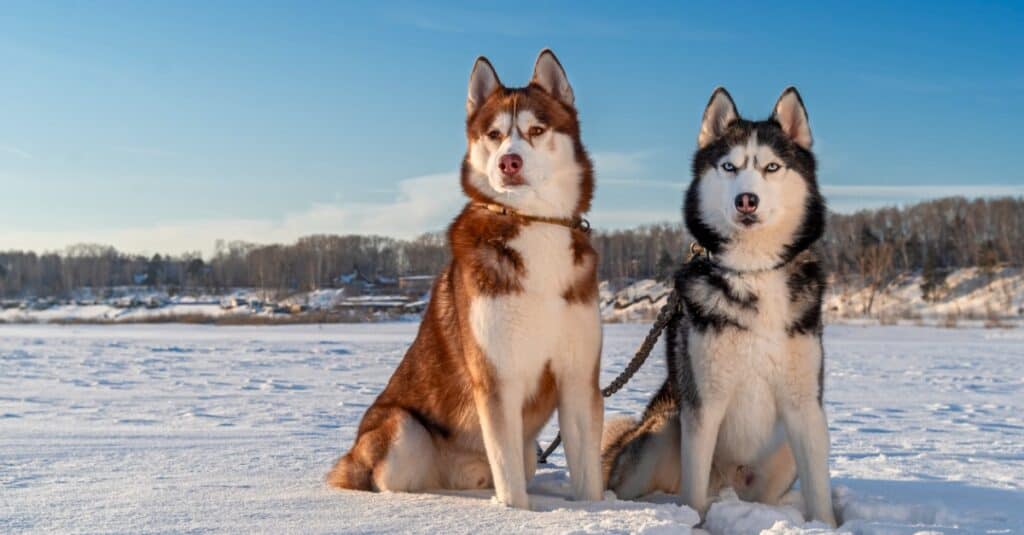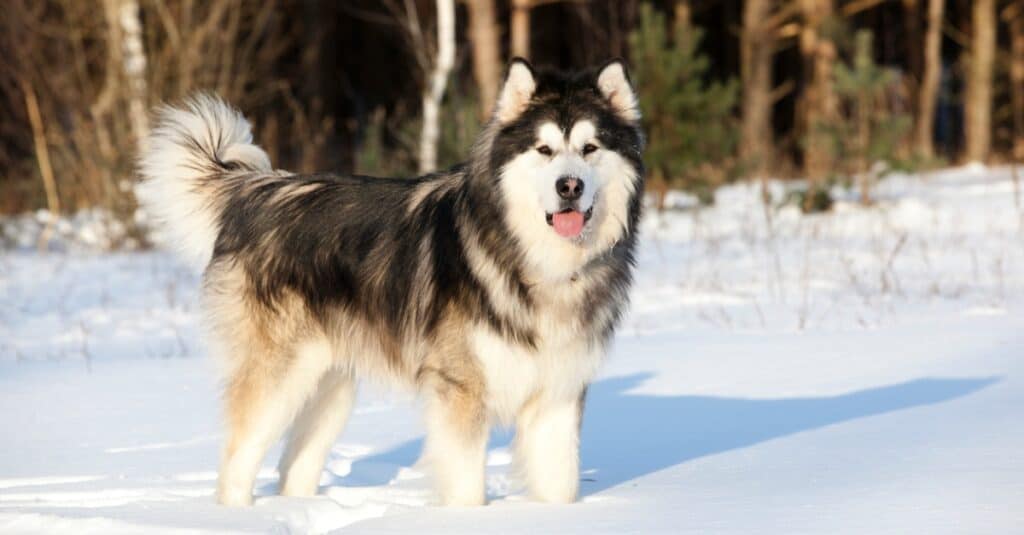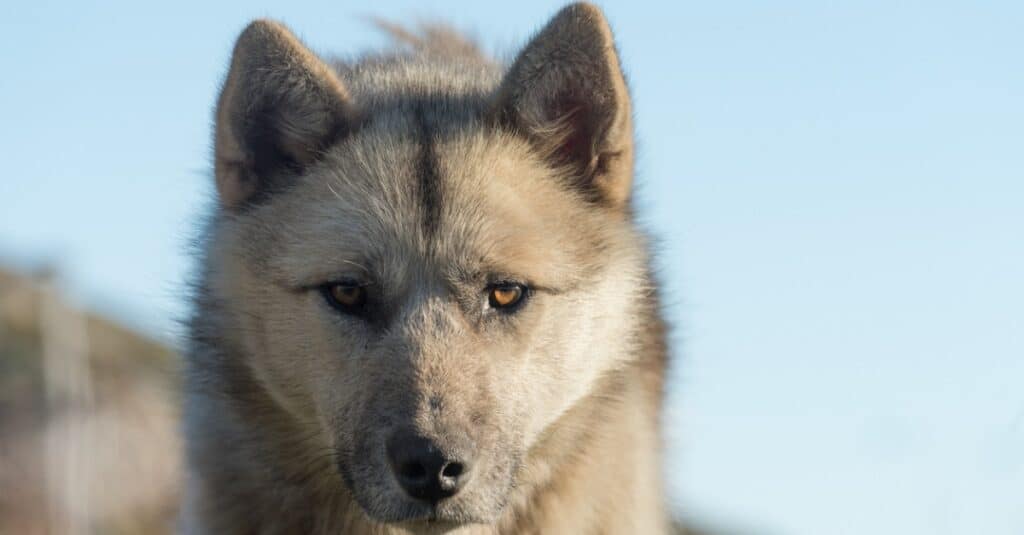Types of Husky Dogs
The husky is a type of northern sled dog that’s well-adapted for the cold Arctic terrain from which it originated. These breeds share many traits in common, including muscular and athletic bodies, deep chests, thick double coats, webbed paws (for traveling over snow), intelligent minds, and a seemingly effortless gait. At some point in the distant past, it’s believed that they were mixed in with wild wolves. This heritage has given them a remarkably wolf-like appearance. But despite some misconceptions, they’re not wolf-dog hybrids. They are 100% legitimate dog breeds.
Today, huskies are rarely used for travel – though they’re a particular highlight of the annual Iditarod, in which teams of 14 sled dogs participate in a grueling multi-day race. They are more often kept in the home as an affectionate and loyal member of the family. Huskies are multi-faceted dogs with an amazing work ethic and a strong desire for social interaction. They excel at hiking, agility training, carting, skiing, and obedience rallies. They’re also quite healthy and long-lived.
However, these breeds are not for everyone. They do require enormous amounts of exercise, plenty of space, abundant grooming, strong obedience training as a puppy, and constant social interactions and companionship. The stubborn streak is also a disqualifying factor for many owners. Huskies frequently end up in animal shelters because the previous owner is unable to handle them. As long as you understand how to care for these types of dogs, however, they are rewarding and affectionate pets.
This article will cover 10 different types of husky dogs. Unfortunately, husky doesn’t have a clear definition other than a kind of northern sled dog. The name husky itself probably originated from a term referencing the aboriginal people and doesn’t tell you anything about its purpose or characteristics. As a result, just about any sled dog will be considered for inclusion in this list.
1. Siberian Husky

iStock.com/Автор
The Siberian Husky is perhaps the most well-known of all the different types of husky dogs. The American Kennel Club ranks it as the 14th most popular dog breed in the United States alone. Originating from the Chukchi people of northern Siberia, the ancestor of the modern Siberian Husky was developed to be an ideal breed for hauling light loads over long distances in sub-zero temperatures. The modern breed came to international prominence in 1925 when legendary musher Leonhard Seppala completed a 658-mile trip over five and a half days to Nome, Alaska with his team of Siberian Huskies.
This breed is medium-sized, weighing around 60 pounds. It has a very thick double coat of black, white, grey, sable, and red fur with saddleback markings and a facial mask. Heterochromia, meaning the phenomenon of two completely different iris colors in each eye, is a common trait in this breed. Many people find the combination of one cool blue iris and another gold or amber-colored iris to be instantly alluring and attractive. This trait appears to have no negative effects on the actual vision of the dog either.
Despite its working origins, the Siberian Husky is a very people-oriented breed with a pleasing temperament. It is extremely affectionate, loyal, outgoing, playful, and a bit mischievous. It loves to interact with people while doing fun activities and games. While they do suffer from hip and eye problems, this breed has a long life expectancy of around 12 to 14 years.
2. Miniature Siberian Husky
For owners who don’t want to deal with such a large dog, some breeders have developed a small version called the Miniature Siberian Husky. Its defining trait is, of course, the comparatively small almost puppy-like size. This dog stands up to 16 inches at the shoulders and weighs no more than 35 pounds as an adult. The temperate and behavior are otherwise the same as the Siberian Husky, but because its small size doesn’t conform exactly to breed standards, it is disqualified from purebred status.
3. Alaskan Husky
The Alaskan Husky was developed with one thing in mind: pulling sleds. All other characteristics, including its appearance, are secondary to its performance. These mongrels were created over many years from crosses with different breeds, including German Shepherds and Greyhounds. As a result, many dog clubs and organizations simply won’t recognize them as legitimate breeds. But they are remarkably good at the singular purpose for which they’re bred.
The Alaskan Husky is perhaps the most common sled dog in the world today. It’s not quite as well-suited as a family companion unless it’s given a lot of work and exercise to do. The Alaskan Husky is a medium-sized dog, normally weighing around 38 to 50 pounds. It is characterized by a short to medium-length coat with any color or pattern accepted.
Alaskan Husky vs. Siberian Husky
The Alaskan Husky and Siberian Husky share many traits in common. They’re both excellent working breeds. They’re both very affectionate toward people. And they like to work in large packs with other like-minded dogs. But the main difference is that the Siberian Husky tends to have a larger body with white fur and darker colors, whereas the Alaskan Husky comes in a much larger range of different coat colors and appearances.
4. Alaskan Malamute

iStock.com/Liliya Kulianionak
An immensely strong and heavy dog weighing up to 85 pounds, the Alaskan Malamute descended directly from the first types of dogs to arrive in the Americas. It is highly affectionate, loyal, and playful, but it also has a rather dignified bearing with the way it carries itself. This breed is characterized by white fur with black, blue, gray, red, sable, or silver colors mixed in. The typical life expectancy is about 10 to 14 years.
5. Samoyed

iStock.com/Abramova_Kseniya
It’s debatable whether the Samoyed is among the many different types of husky dogs. This breed was developed by the Samoyedic people of Siberia as an all-purpose working dog to herd reindeer and hunt prey. Nevertheless, it is also a talented sled dog with a muscular medium size body and boundless energy. Sporting a luxurious all-white coat of fur, the Samoyed is known for its incredibly infectious “smile” and upbeat personality. While people of all ages can enjoy this breed, it’s especially well-suited for homes with children. It has a life expectancy of 12 to 14 years.
6. Greenland Dog

LouieLea/Shutterstock.com
Originally brought to the island of Greenland by the Thule people around 1000 AD, the Greenland Dog is an iconic breed of its native homeland, historically used to pull sleds and hunt bears and seals. It has a typical husky-like temperament: affectionate, rowdy, independent, and very playful. As a result, training this breed can be quite a challenge as a puppy and not for the faint of heart. The dog has a thick double coat of black, white, fawn, brown, and many other possible color combinations.
7. Canadian Eskimo Dog
Some people consider this to be the same breed as the Greenland Dog; both of them have a very similar temperament and appearance. Their near-identical genetic profile also attests to their similar origins. But the Canadian Eskimo is considered to be slightly heavier than the Greenland Dog with a thick mane of fur around the entire neck. Just about any color combination and markings are accepted.
8. Labrador Husky
This exceptionally rare breed is not, as some people may assume, a cross between a Labrador Retriever and a Siberian Husky. This is instead an entirely separate breed with its own unique identity and history. It was brought to the Labrador region of Canada by the Inuit people around 1300 AD. While only distantly related to the Siberian Husky, it nevertheless has a very similar appearance, affectionate temperament, and hard-working behavior. This large breed weighs up to 90 pounds and stands around 26 inches at the shoulders. The dense, wavy coat can come in black, brown, red, gray, white, and even pied colors.
9. Mackenzie River Husky

iStock.com/Alexandre Patchine
The Mackenzie River Husky isn’t a well-defined breed. Instead, it’s a general catch-all term for several different overlapping types of dogs from northwestern Canada. It can be defined as a sled dog from the Yukon Territory region that was crossed with European breeds such as St. Bernard or Newfoundland to create a powerful hauling dog. Many of these dogs are quite rare and not very well-known outside of their homeland.
10. Sakhalin Husky
The Sakhalin Husky is another exceptionally rare breed. As the name suggests, it originated from the large island of Sakhalin, just north of Japan, now a part of Russia. This relatively large-sized dog, weighing between 66 to 88 pounds, is characterized by black, russet, and even cream markings. It is remarkably alert, loyal, intelligent, and active. Unfortunately, only a few of them remain anywhere in the world.
More from A-Z Animals
The husky is a type of northern sled dog that’s well-adapted for the cold Arctic terrain from which it originated. These breeds share many traits in common, including muscular and athletic bodies, deep chests, thick double coats, webbed paws (for traveling over snow), intelligent minds, and a seemingly effortless gait. At some point in the distant past, it’s believed that they were mixed in with wild wolves. This heritage has given them a remarkably wolf-like appearance. But despite some misconceptions, they’re not wolf-dog hybrids. They are 100% legitimate dog breeds.
Today, huskies are rarely used for travel – though they’re a particular highlight of the annual Iditarod, in which teams of 14 sled dogs participate in a grueling multi-day race. They are more often kept in the home as an affectionate and loyal member of the family. Huskies are multi-faceted dogs with an amazing work ethic and a strong desire for social interaction. They excel at hiking, agility training, carting, skiing, and obedience rallies. They’re also quite healthy and long-lived.
However, these breeds are not for everyone. They do require enormous amounts of exercise, plenty of space, abundant grooming, strong obedience training as a puppy, and constant social interactions and companionship. The stubborn streak is also a disqualifying factor for many owners. Huskies frequently end up in animal shelters because the previous owner is unable to handle them. As long as you understand how to care for these types of dogs, however, they are rewarding and affectionate pets.
This article will cover 10 different types of husky dogs. Unfortunately, husky doesn’t have a clear definition other than a kind of northern sled dog. The name husky itself probably originated from a term referencing the aboriginal people and doesn’t tell you anything about its purpose or characteristics. As a result, just about any sled dog will be considered for inclusion in this list.
1. Siberian Husky

iStock.com/Автор
The Siberian Husky is perhaps the most well-known of all the different types of husky dogs. The American Kennel Club ranks it as the 14th most popular dog breed in the United States alone. Originating from the Chukchi people of northern Siberia, the ancestor of the modern Siberian Husky was developed to be an ideal breed for hauling light loads over long distances in sub-zero temperatures. The modern breed came to international prominence in 1925 when legendary musher Leonhard Seppala completed a 658-mile trip over five and a half days to Nome, Alaska with his team of Siberian Huskies.
This breed is medium-sized, weighing around 60 pounds. It has a very thick double coat of black, white, grey, sable, and red fur with saddleback markings and a facial mask. Heterochromia, meaning the phenomenon of two completely different iris colors in each eye, is a common trait in this breed. Many people find the combination of one cool blue iris and another gold or amber-colored iris to be instantly alluring and attractive. This trait appears to have no negative effects on the actual vision of the dog either.
Despite its working origins, the Siberian Husky is a very people-oriented breed with a pleasing temperament. It is extremely affectionate, loyal, outgoing, playful, and a bit mischievous. It loves to interact with people while doing fun activities and games. While they do suffer from hip and eye problems, this breed has a long life expectancy of around 12 to 14 years.
2. Miniature Siberian Husky
For owners who don’t want to deal with such a large dog, some breeders have developed a small version called the Miniature Siberian Husky. Its defining trait is, of course, the comparatively small almost puppy-like size. This dog stands up to 16 inches at the shoulders and weighs no more than 35 pounds as an adult. The temperate and behavior are otherwise the same as the Siberian Husky, but because its small size doesn’t conform exactly to breed standards, it is disqualified from purebred status.
3. Alaskan Husky
The Alaskan Husky was developed with one thing in mind: pulling sleds. All other characteristics, including its appearance, are secondary to its performance. These mongrels were created over many years from crosses with different breeds, including German Shepherds and Greyhounds. As a result, many dog clubs and organizations simply won’t recognize them as legitimate breeds. But they are remarkably good at the singular purpose for which they’re bred.
The Alaskan Husky is perhaps the most common sled dog in the world today. It’s not quite as well-suited as a family companion unless it’s given a lot of work and exercise to do. The Alaskan Husky is a medium-sized dog, normally weighing around 38 to 50 pounds. It is characterized by a short to medium-length coat with any color or pattern accepted.
Alaskan Husky vs. Siberian Husky
The Alaskan Husky and Siberian Husky share many traits in common. They’re both excellent working breeds. They’re both very affectionate toward people. And they like to work in large packs with other like-minded dogs. But the main difference is that the Siberian Husky tends to have a larger body with white fur and darker colors, whereas the Alaskan Husky comes in a much larger range of different coat colors and appearances.
4. Alaskan Malamute

iStock.com/Liliya Kulianionak
An immensely strong and heavy dog weighing up to 85 pounds, the Alaskan Malamute descended directly from the first types of dogs to arrive in the Americas. It is highly affectionate, loyal, and playful, but it also has a rather dignified bearing with the way it carries itself. This breed is characterized by white fur with black, blue, gray, red, sable, or silver colors mixed in. The typical life expectancy is about 10 to 14 years.
5. Samoyed

iStock.com/Abramova_Kseniya
It’s debatable whether the Samoyed is among the many different types of husky dogs. This breed was developed by the Samoyedic people of Siberia as an all-purpose working dog to herd reindeer and hunt prey. Nevertheless, it is also a talented sled dog with a muscular medium size body and boundless energy. Sporting a luxurious all-white coat of fur, the Samoyed is known for its incredibly infectious “smile” and upbeat personality. While people of all ages can enjoy this breed, it’s especially well-suited for homes with children. It has a life expectancy of 12 to 14 years.
6. Greenland Dog

LouieLea/Shutterstock.com
Originally brought to the island of Greenland by the Thule people around 1000 AD, the Greenland Dog is an iconic breed of its native homeland, historically used to pull sleds and hunt bears and seals. It has a typical husky-like temperament: affectionate, rowdy, independent, and very playful. As a result, training this breed can be quite a challenge as a puppy and not for the faint of heart. The dog has a thick double coat of black, white, fawn, brown, and many other possible color combinations.
7. Canadian Eskimo Dog
Some people consider this to be the same breed as the Greenland Dog; both of them have a very similar temperament and appearance. Their near-identical genetic profile also attests to their similar origins. But the Canadian Eskimo is considered to be slightly heavier than the Greenland Dog with a thick mane of fur around the entire neck. Just about any color combination and markings are accepted.
8. Labrador Husky
This exceptionally rare breed is not, as some people may assume, a cross between a Labrador Retriever and a Siberian Husky. This is instead an entirely separate breed with its own unique identity and history. It was brought to the Labrador region of Canada by the Inuit people around 1300 AD. While only distantly related to the Siberian Husky, it nevertheless has a very similar appearance, affectionate temperament, and hard-working behavior. This large breed weighs up to 90 pounds and stands around 26 inches at the shoulders. The dense, wavy coat can come in black, brown, red, gray, white, and even pied colors.
9. Mackenzie River Husky

iStock.com/Alexandre Patchine
The Mackenzie River Husky isn’t a well-defined breed. Instead, it’s a general catch-all term for several different overlapping types of dogs from northwestern Canada. It can be defined as a sled dog from the Yukon Territory region that was crossed with European breeds such as St. Bernard or Newfoundland to create a powerful hauling dog. Many of these dogs are quite rare and not very well-known outside of their homeland.
10. Sakhalin Husky
The Sakhalin Husky is another exceptionally rare breed. As the name suggests, it originated from the large island of Sakhalin, just north of Japan, now a part of Russia. This relatively large-sized dog, weighing between 66 to 88 pounds, is characterized by black, russet, and even cream markings. It is remarkably alert, loyal, intelligent, and active. Unfortunately, only a few of them remain anywhere in the world.






